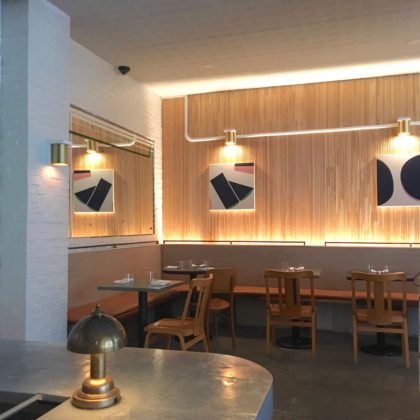Categories
Left column house ads
In the News: Inside the Tribeca Home of a “QVC Star”
August 14, 2018 Community News, Real Estate, Restaurant/Bar News
••• “QVC star” Lori Goldstein talked to Isaac Mizrahi about her apartment. I don’t think it’s an advertorial for 30 Park Place, but it sure reads that way. —Elle Decor
••• And Sight Unseen visited “the Curio-Filled Tribeca Loft of Table of Contents Founder Joe Magliaro”; TOC was a shop in Portland, Oregon, and the post is definitely semi-advertorial. P.S. I want glossy black herringbone floors!
••• “Exactly how hot and disgusting are the [subway] platforms lately? The Regional Plan Association aimed to answer that question this week by heading to the 10 busiest subway stations […] to see how the temperatures underground compared to those outside. […] The hottest spot to wait for a train was the 4/5/6 platform at the Union Square stop; at 1 p.m. yesterday, it registered at a whopping 104 degrees, compared to 86 degrees outside. A few other stations, including the 1 platform at 59th Street-Columbus Circle, and the 4/5/6 at Brooklyn Bridge-City Hall, also cracked 100 degrees. Many more registered temperatures in the high 90s.” —Curbed
••• An article about how the word “organic” isn’t all that meaningful, especially in regard to restaurants, takes Bareburger to task for not being 100% organic. But the chain is still trying harder than a lot of other ones, so if you really care about “organic” you’re probably better off there that at its competition. And if your health is important to you, you should stay away from fast food in general. —New York Times
••• “De Maria is dead. The chic Kenmare Street cafe closed down last week after little more than two years in business.” —Bowery Boogie
2 Comments
Comment:
Subscribe
Subscribe to the TC Newsletter















Isn’t the excessive heat of the subway platforms caused by the excessive air conditioning of the cars?
Yes. See RPA’s ideas to combat this:
http://library.rpa.org/pdf/RPA-Save-Our-Subways.pdf
Based on the experience of London and other cities, and
leveraging investments made to restore the system, several
strategies could significantly cool stations throughout the
subway system. Many of these overlap with strategies to
make the subways more energy efficient, simultaneously
reducing power needs and costs:
Leverage benefits of regenerative braking to reduce heat:
Regenerative braking has the potential to reduce the
amount of heat generated by braking trains as well as the
amount of energy required to operate the subway, which
can also improve the environment and health in communi-
ties outside of New York City.
Lower the weight of subway cars:
According to the MTA
Blue Ribbon Commission on Sustainability, weight reduc-
tions of 2,000lbs per Division B car can be realized by pursuing “all reasonable light weighting technology”. Such
a reduction will also decrease train power draws by 2.5%.This light weighting can be applied to all new built roll-
ing stock as well as the 4,800 car overhaul eligible fleet. As
noted earlier, open gangway trainsets would also be lighter
and should be pursued as the fleet is replaced.
Rethink how to more efficiently cool subway cars:
Subway
car air conditioning has introduced an excessive amount of
heat into the system. Straphangers can feel the temperature
elevate when a train is idling at a station during a summer
day. Moving from a sweltering station to a freezing cold car
is unhealthy. Other methods to cool cars instead of conven-
tional air conditioning should be explored. Improvements
in ventilation over the tracks could also help divert some
of this heat, but this intervention is infeasible in many of
the older stations. It may also be healthier to reduce the
amount of air conditioning in cars to generate less external
heat and reduce the differential in temperature between
trains and platforms.
Fully leverage benefits CBTC including features such as
“Coasting” which limits braking:
The implementation of
CBTC would reduce the amount of energy used and the
heat generated by trains by allowing for more efficient train
movements and less unnecessary braking. CBTC enables
each train to know where all the trains in the system are
located which allows them to determine how to maintain
their distance using their current forward inertia and only
apply the brakes when absolutely necessary . This is a far
cry from the stop and go approach that is typical of most
manually operated trains, where the train operator must
respond to signals and has no real-time knowledge of the
precise distance between his/her train and the leading one.
Improve ventilation plants and pursue other methods to
cool/temper station environments:
Opportunities may also
exist for the improvement of tunnel ventilation to reduce
heat levels. According to the 2015 — 2019 MTA Capital Plan,
only 60% of ventilation facilities are currently in a state of
good repair. Station ventilation and cooling projects may also be considered as part of public transit bonuses for real
estate development. The MTA Blue Ribbon Commission on
Sustainability has also recommended investigating poten-
tial uses for pumped groundwater. These uses may include
station cooling as well as heating of nearby buildings.
Design future subway lines to generate less heat and be
more energy efficient:
Future subway lines can be engineered to allow for more energy efficient and less heat
generating performance. For instance, they could include
“humped tracks” between stations (used on the Lexington
Avenue line between Union Square and GCT), harnessing
the power of gravity to assist with acceleration and braking. Turns can also be designed to reduce the need for
unnecessary braking between stations and to maximize the
benefits of coasting.